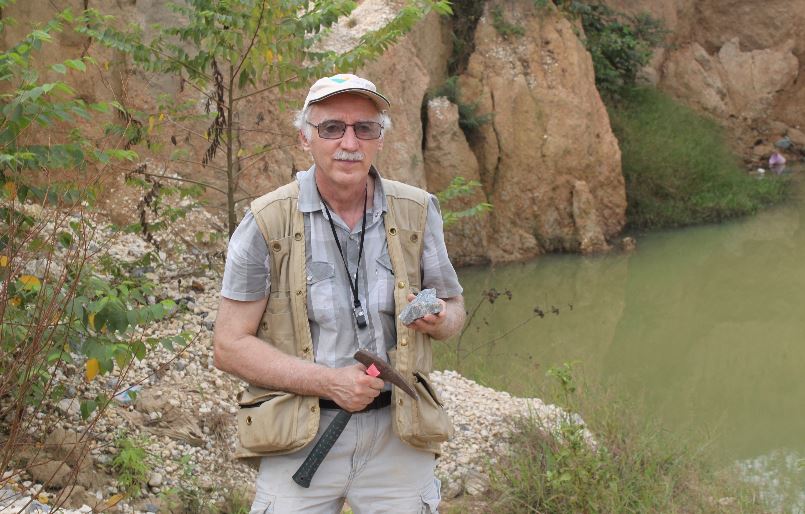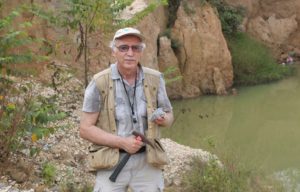Assante Gold drills 13.12 g/t gold over 3.0 metres in Ghana

MacQuarrie, President & CEO of Asante Gold, at the MEM showing on the Keyhole Project in Ghana, West Africa. Source: Asante Gold Corp.

Asante Gold Corp. [ASE-CSE; 1A9-FSE; ASGOF- OTC] has received final assay results from the first drilling program in the historical MEM shaft/showing area on its Keyhole optioned property in the Asankrangwa gold belt, Ghana, West Africa.
The program was designed as the first modern drill test of bedrock for gold mineralization in a structurally favourable area where extensive alluvial mining has been ongoing over the last 30 years.
The program consisted of 1,151metres of diamond drilling in 12 holes, surface sampling and ground geophysics and has confirmed that the MEM showing is part of a northeast-trending gold mineralized shear that is in excess of 250 metres in length, 120 metres in depth, and is open to extension in all directions. Based on the success of this initial program, an expanded program to further test and extend the zone and outline other potential mineralized zones is being planned.
Five holes were spotted in the MEM area where recent grab samples of sulfidic and vuggy quartz reef dump material from artisanal shafts averaged 15.5 g/t gold, and historical underground sampling results to 8 metres widths grading 25g/t gold were reported by Junner, Gold Coast Geological Survey, 1933.
Drillhole MEM17-001B was spotted to test directly under the old MEM shaft area and intersected 13.12 g/t gold over 3.0 metres at a down hole depth of 139 metres. The intersection was vertically ~120 metres below the showing in a graphitic shear zone hosted in meta-greywacke/argillite, with quartz, sulfide mineralization and with minor visible gold noted. Core orientation data suggest that the shear zone is sub-parallel to the regional foliation at azimuth 030 to 046 degrees with a moderate to steep dip to the northwest. A photo of the mineralization is at: http://www.asantegold.com/assets/docs/pdf/nr/MEM17-001b 140.3m.pdf .
Drillhole MEM17-002 was drilled 85 metres to the southwest of the MEM showing, and intersected two shear zones grading 3.43 g/t over 3.0 metres and 3.46 g/t over 1.5 metres at down hole depths of 64.5 and 75.0 metres, Â respectively.
Drillhole MEM17-010B tested the structure 60m to the northeast of the MEM showing intersecting a narrow shear zone that graded 2.0 g/t gold over 0.3 metres. Two of the five drill holes had to be abandoned – one in heavily fractured ground/shear zone and the other in brecciated quartz/greywacke and mud filled underground workings.
In addition, 25 surface grab/channel samples over ~1.0-metre widths were taken in recently exposed saprolite in an area ~120 metres to the northeast of the MEM showing, with the best section grading 1.89 g/t over 3 metres.
The balance of the drillholes were collared to test anomalous IP and interpreted structural targets from a recent ground geophysical orientation program. Regional scale-fracture controlled pyrite mineralization was intersected, accounting for many of the noted IP responses. Areas with interpreted high resistivities appear related to thicker sections of greywacke interbedded with the argillaceous phyllite host.
A map showing the MEM area drill collars and significant gold intersections is available at: http://www.asantegold.com/assets/docs/pdf/nr/MEMdrillPlan.pdf . Recent pictures from the drill program are available at: http://www.asantegold.com/projects/keyhole-option .
The Keyhole Option covers a 6-km long section of the Ankobra River and is strategically located at the intersection of three major regional gold mineralized trends:
- the Asankrangwa Gold Belt which hosts ~11 million ounces of gold resources at the Asanko Gold Mine (formerly known as PMI Gold Corp.’s Obotan Mine), and Esaase gold projects located 36 km and 60 km respectively to the northeast;
- a major continental-scale basement structure noted on regional aeromagnetic surveys which is spatially related to the 66 million ounce AngloGold Ashanti Obuasi Mine and the 7.6 million ounce* Newmont Akyem Mine, located 57 km and 130 km to the east northeast; and
Keyhole, under option from Sikasante Mining Company Limited, adjoins Asante’s Ashanti II Gold project. Asante can earn up to 100% in the Keyhole Gold Project by completing $500,000 in work over four years, issuing 1.25 million shares, and reserving for Sikasante a 2% net smelter return royalty.
Douglas MacQuarrie, President & CEO, said, “These drill results are highly encouraging and reinforce our confidence in the potential for finding further gold mineralization at Keyhole. An expanded program will look at extending the mineralized zones as well as test further areas within the property with gold potential.”
